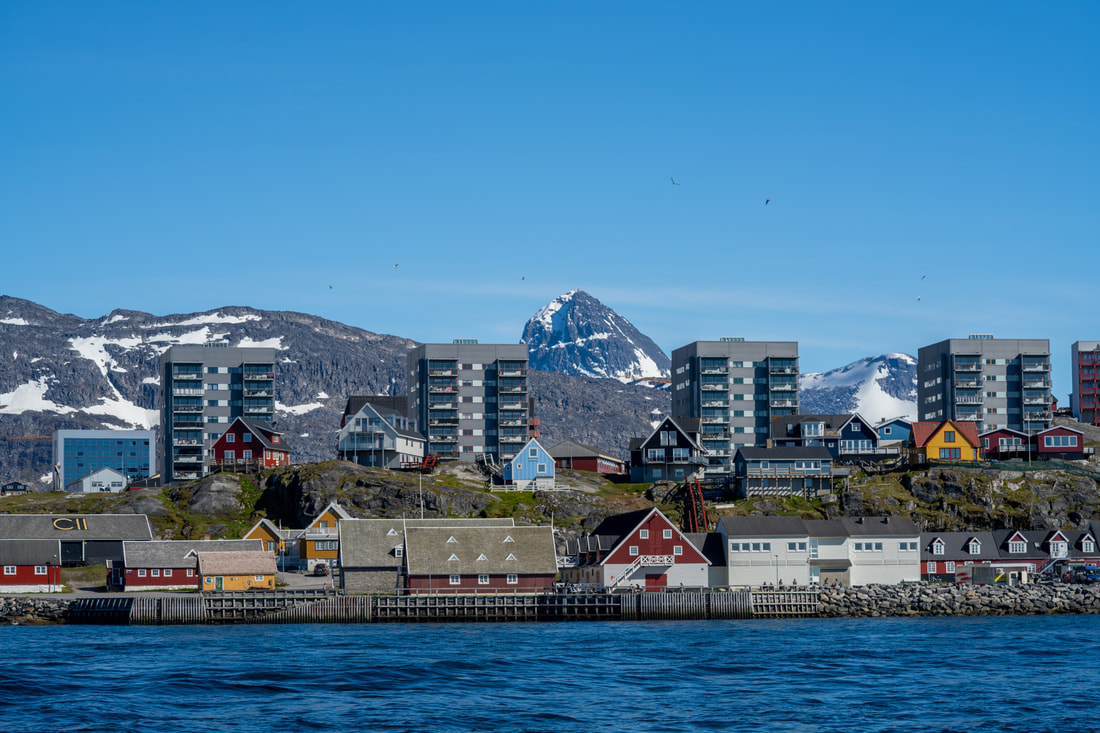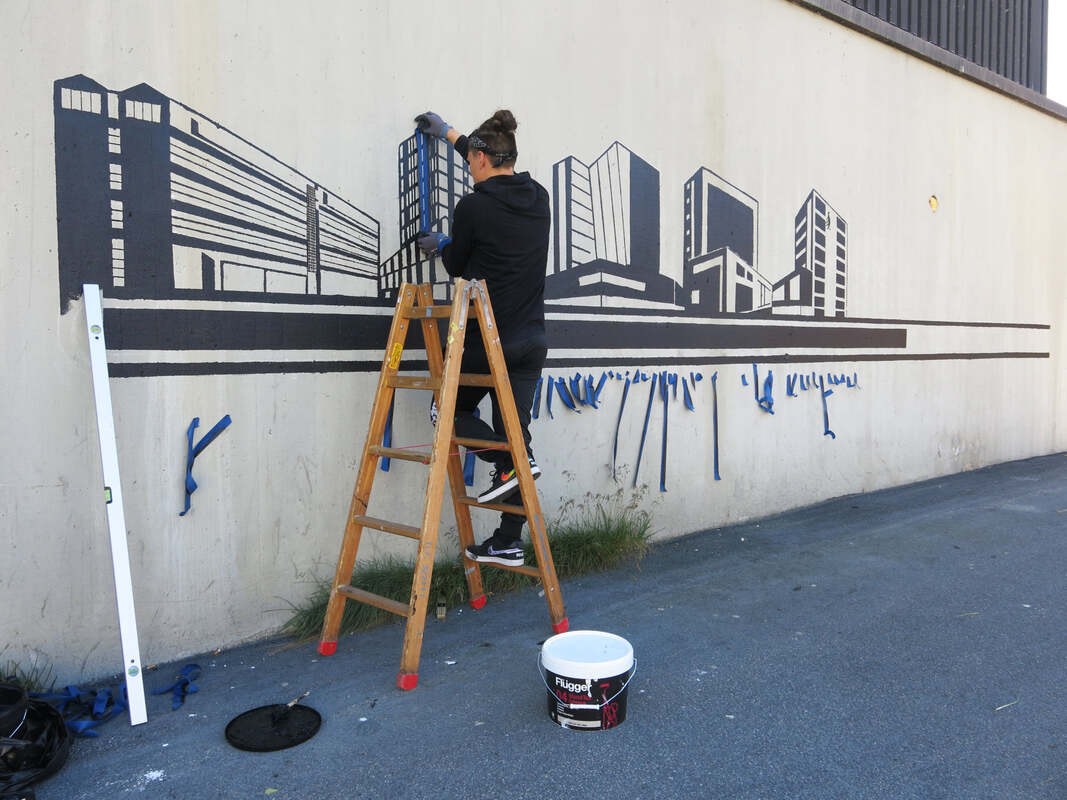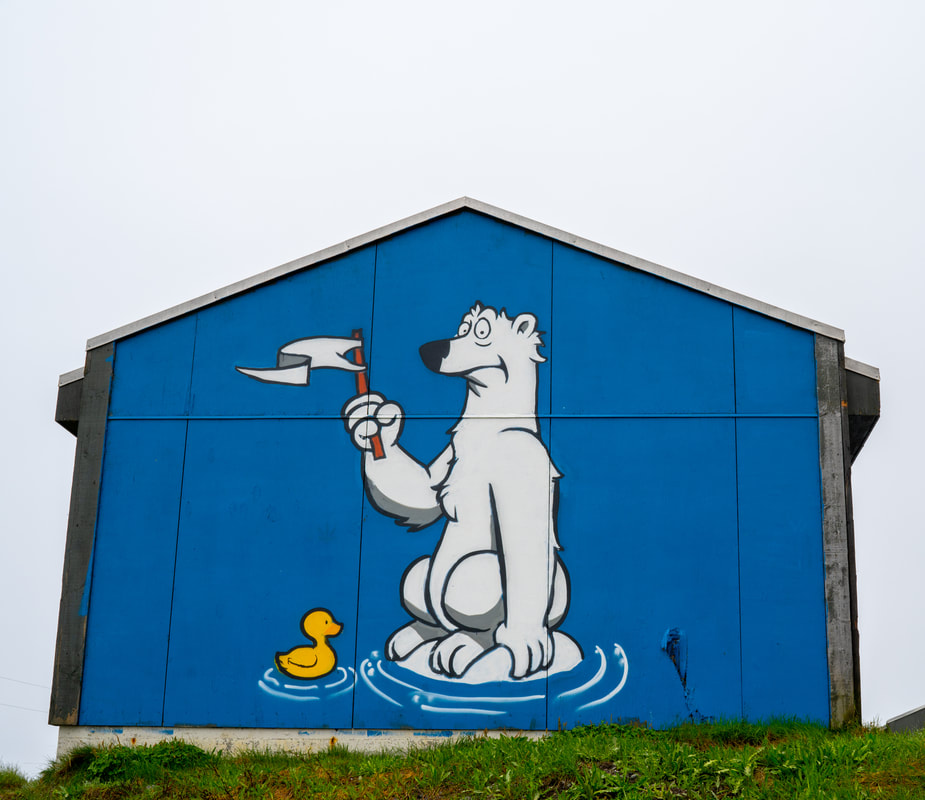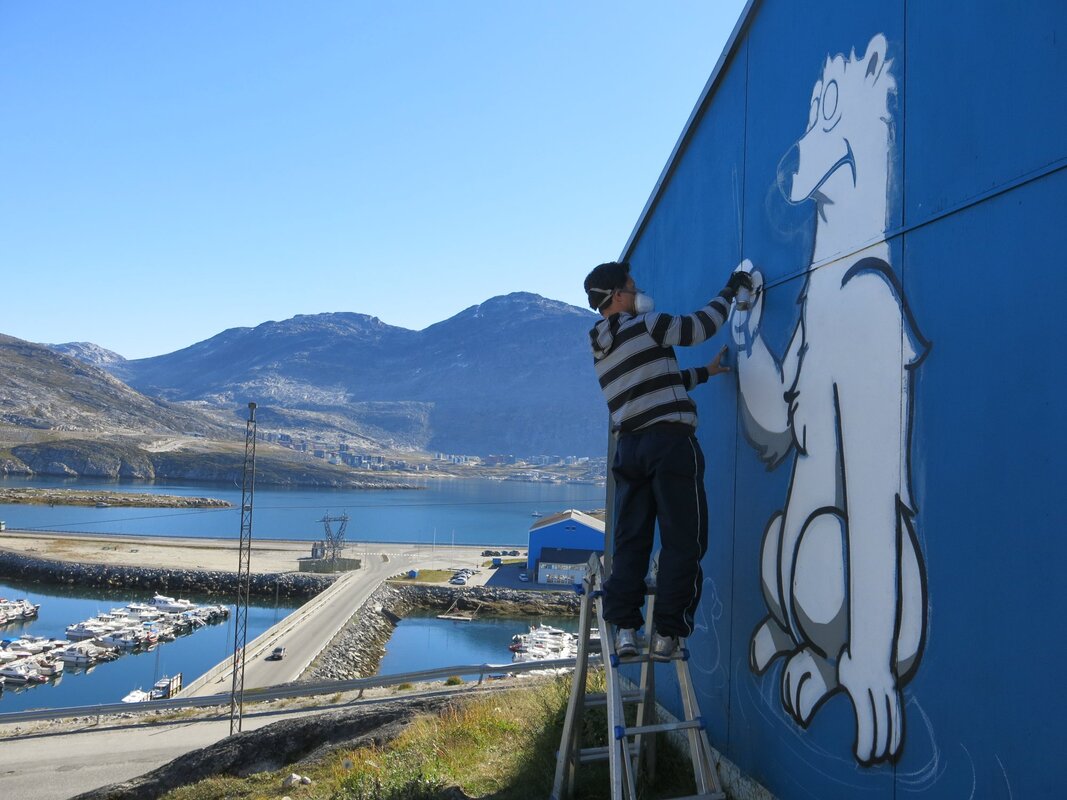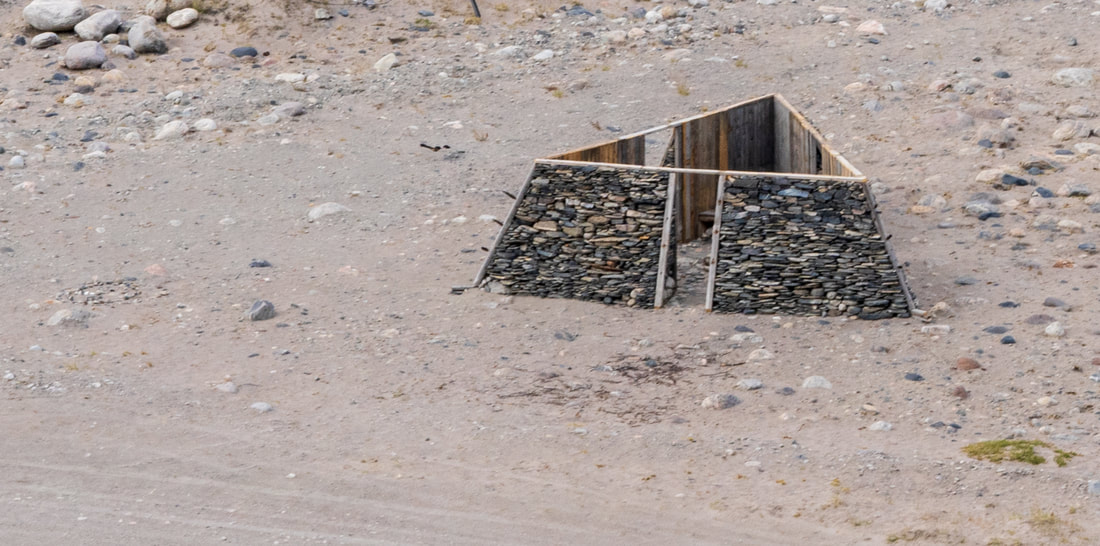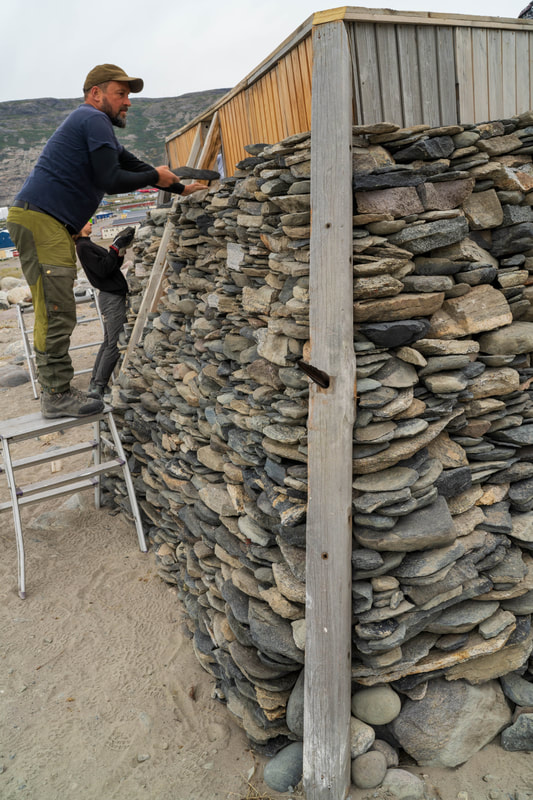This story is part of a larger Greenland project.
For more photography from Greenland, see my Flickr album.
See more Greenland stories here.
For more photography from Greenland, see my Flickr album.
See more Greenland stories here.
1) Environmental Street Art in Greenland’s Capitol City
“Just 80 years ago, nearly 70 percent of Greenlanders lived in small communities of fewer than 200 people; today, only 7 percent do.” (source)
“Just 80 years ago, nearly 70 percent of Greenlanders lived in small communities of fewer than 200 people; today, only 7 percent do.” (source)
Greenland’s capitol, Nuuk, is its largest city by far. About a third of Greenland’s total population of nearly 57,000 people live here. Most people in Greenland live in small, scattered villages in southern and western Greenland still dependent to a large degree on harvesting local resources like fish.
There is a striking difference between “the big city” of Nuuk and the rest of Greenland. Multiple cranes loom above Nuuk’s one mall, multiple bus lines, supermarkets, multistory bank headquarters, bars, and university, reflecting its continuing development.
There is a striking difference between “the big city” of Nuuk and the rest of Greenland. Multiple cranes loom above Nuuk’s one mall, multiple bus lines, supermarkets, multistory bank headquarters, bars, and university, reflecting its continuing development.
A massive construction project is taking place at Nuuk’s airport to expand its runway to cater to larger planes and thus gain access to more direct international flights. At present, Kangerlussuaq—about 200 miles to the north—is one of only two airports that can handle such large aircraft. The airport in the tourist hub of Illulisat—another 150 miles north of Nuuk—is also undergoing such an expansion.
This change is powerfully captured in a work of street art by local artist Inuk Højgaard from southern Greenland. The piece depicts a city skyline of looming black and steel grey buildings—perfectly rectangular and severely modern—enveloped by emissions from a smokestack—conquering a tiny idyllic village with brightly colored houses in the Greenlandic traditional style, ringed by snowy mountains and bright blue skies. Underneath it all is a loading computer bar, filled in right to the point of the busy cranes.
My first impression of the work was a critical indictment of runaway growth and inescapable uniformity systematically replacing the traditional village life that preceded it. However, when I spoke with Inuk, he indicated that this is too simplistic of a conclusion.
My first impression of the work was a critical indictment of runaway growth and inescapable uniformity systematically replacing the traditional village life that preceded it. However, when I spoke with Inuk, he indicated that this is too simplistic of a conclusion.
“Loading”, like all art, is open to interpretation. It is not necessarily meant as a critical reflection on Nuuk’s present course. In fact, when a couple of local officials saw a preliminary sketch of the work, they wished it could be moved to City Hall rather than its present location. Inuk instead indicated that his primary inspiration was the striking difference between Nuuk and other parts of Greenland including his native village in the south. The differing pace of life and development between the two is stark.
“Loading” was created as part of a graffiti masterclass taught by Nuuk-residing Danish artist Sacha Malinský. Sacha was certain that “Loading” should be on a prominent building in town but permission was hard to get because “graffiti” still has negative connotations. Once they saw the sketch however officials allowed it to move forward.
When I spoke with Sacha, she insisted that the contributions from Inuk and others in her class are particularly valuable as they are coming directly from Greenlanders themselves.
“Loading” was created as part of a graffiti masterclass taught by Nuuk-residing Danish artist Sacha Malinský. Sacha was certain that “Loading” should be on a prominent building in town but permission was hard to get because “graffiti” still has negative connotations. Once they saw the sketch however officials allowed it to move forward.
When I spoke with Sacha, she insisted that the contributions from Inuk and others in her class are particularly valuable as they are coming directly from Greenlanders themselves.
Sacha’s masterclass has produced art that is scattered throughout Nuuk, including an image of a cartoon polar bear in desperate circumstances reflecting the impacts of climate change in the Arctic.
2) International Architecture Collective, Project 67, Inaugurates Their Pan-Arctic Project in Greenland
Fifteen architects and artists from all over the world converged in Kangerlussuaq Greenland for a week in August 2021 to design and construct a structure that fit perfectly into the local landscape. For most of them, this was their first time in Greenland. Members of the private group traveled from places as varied as Finland, Denmark, Switzerland, the Netherlands, Spain, and the U.S., while five were students from other towns in Greenland. They arrived with no definitive plan and with limited time.
Fifteen architects and artists from all over the world converged in Kangerlussuaq Greenland for a week in August 2021 to design and construct a structure that fit perfectly into the local landscape. For most of them, this was their first time in Greenland. Members of the private group traveled from places as varied as Finland, Denmark, Switzerland, the Netherlands, Spain, and the U.S., while five were students from other towns in Greenland. They arrived with no definitive plan and with limited time.
They began by spending a full day taking in the local landscape, which culminated in a hike up a nearby mountain. With their varying backgrounds, the team had to all agree on a design that could do justice to the unique qualities of the place they had just witnessed. They noticed that the area was defined by three elements: the mountain, the sea, and the river upon which Kangerlussuaq sits. Their structure is thus built around this tripartite scene with each of its three doors framing one of those natural features.
The group also wanted to build something inspired by the local culture and useful to the local people. The layout is thus modeled after a stylized set of raven claws—the raven has strong significance in Inuit culture. While within the building are three benches and a firepit, allowing visitors to enjoy the landscape in a cozy setting.
The group also wanted to build something inspired by the local culture and useful to the local people. The layout is thus modeled after a stylized set of raven claws—the raven has strong significance in Inuit culture. While within the building are three benches and a firepit, allowing visitors to enjoy the landscape in a cozy setting.
Members of Project 67 working on “Raven Claw” structure in Kangerlussuaq. Each doorway frames a different element of the local landscape. Photos by Chris Dunn
The structure is built entirely of local materials including rocks and items, especially wood from old doors and shipping boxes, scavenged from the nearby dump. The team decided to avoid metal in part to give a more natural look and in part to minimize construction requirements. “Raven claw” is almost entirely handmade, using very few power tools.
This is the international collaborative’s first completed structure of a planned series in select Arctic villages along the 67th parallel using local and discarded materials. Their next stops are Norway, Siberia, Sweden, and Finland.
This is the international collaborative’s first completed structure of a planned series in select Arctic villages along the 67th parallel using local and discarded materials. Their next stops are Norway, Siberia, Sweden, and Finland.
3) More Greenlandic Contemporary Art


